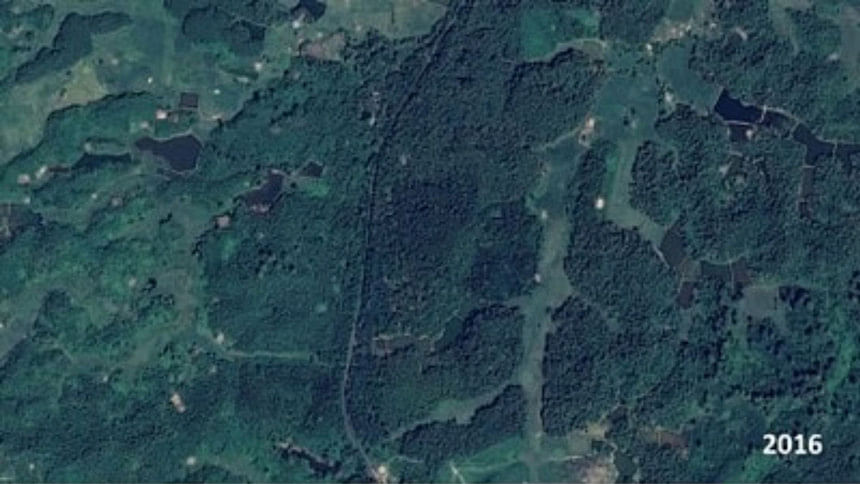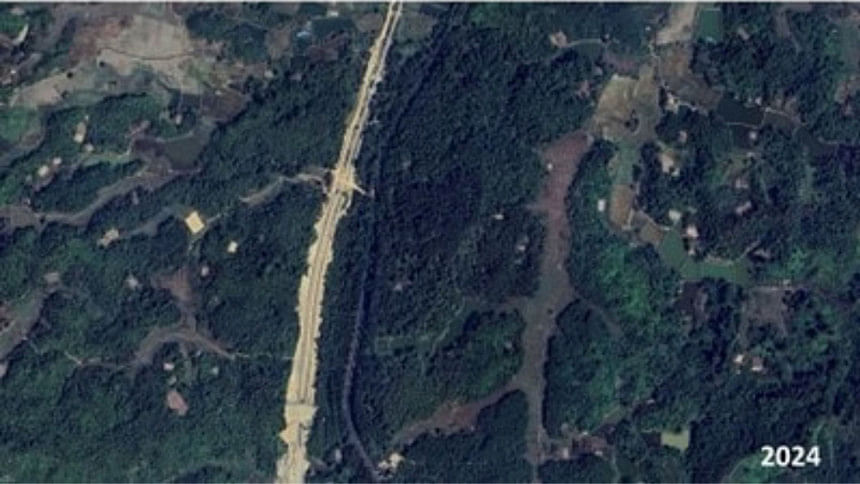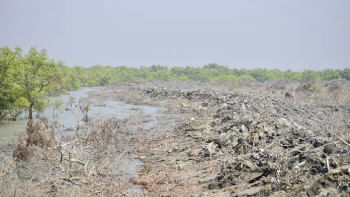Forests in Bangladesh are disappearing when we need them most

Bangladesh was once known for its lush greenery and biodiversity. But at present, the country faces significant challenges in preserving its forests, with the rate of deforestation almost double the global average due to land use change and human activities. According to the Food and Agriculture Organization (FAO), Bangladesh's forest cover is estimated to be 2.33 million hectares (15.78 percent of land), whereas the Forest Department says it is 2.57 million hectares (17.31 percent of land).
Over the past two decades, Bangladesh has witnessed a concerning loss of 8,390 hectares of humid primary forest, accounting for 3.5 percent of all tree cover depletion during this time. The country saw a significant decrease of 8.7 percent in the total area of humid primary forest.
Land use change, primarily driven by agricultural expansion, urbanisation and infrastructure development, has led to the degradation and fragmentation of forest lands in Bangladesh.
While agriculture is a cornerstone of our economy, finding a balance between agricultural productivity and forest conservation is crucial. According to a report in 1973, at least 9,749.98 hectares of Madhupur forest was completely covered with sal forest, whereas in 2015 the forest converted to acacia, pineapple, rubber, banana plantation, mixed forestry, agriculture and marsh, leaving only 2,671.99 hectares of actual sal forest. Initiated in 1989-1990 with ADB funding, social forestry cleared natural sal forests for exotic eucalyptus and acacia plantations of around 5,000 acres. In recent years, the Chittagong Hill Tract (CHT) forests have been illegally razed for cassava farming, destroying rich biodiversity.
Social forestry initiatives, which involve planting fast-growing species like eucalyptus and acacia, aim to meet the demand for timber and fuelwood. However, these plantations are usually harvested within a short period, raising concerns about their long-term sustainability and ecological benefits compared to natural forests. These fast-growing species of trees tend to dominate their locales, preventing ecological and biodiversity balance. Eucalyptus consumes 18-20 times more water than many other species and can negatively impact the water table. In areas with more limited rainfall, such as in northern Bangladesh and along the Barind Tract, this exacerbates environmental impacts.
According to the Forest Department, social forestry in Bangladesh has caused significant ecological and social issues. From 1981 to 2022, as many as 105,283 hectares of woodlot plantations and 78,832 kilometres of strip plantations were established, predominantly with harmful exotic species such as eucalyptus and acacia. Fundamentally with social forestry, these are trees being planted to be cut down. This cannot possibly be a replacement for the protection of our natural forests and, as such, the modality of social forestry must be rethought.
Development projects have emerged as a major threat to the conservation of our forests. Too often, forest land is seen as expendable and lucrative when allocating for large development projects, running contrary to environmental obligations. The development agenda has not as yet integrated sustainability and conservation into its ethos. Adverse environmental impacts are seen as unavoidable in the pursuit of economic growth.


The Chattogram-Cox's Bazar rail link, a major government project, threatens forests and wildlife habitats despite its benefits to communication and transportation infrastructure. Spanning 101km, the railway passes through Chunati Wildlife Sanctuary, Fasiakhali Wildlife Sanctuary, and Medhkachapia National Park, home to endangered species like Asian elephants. Despite plans of underpasses and overpasses for the elephants' movement, experts and officials believe this is inadequate. It has been reported that the project cut over 720,000 trees and razed parts of 26 hills. The construction severely impacted wildlife, exacerbating human-wildlife conflicts. Repeated protests from forest authorities, local and national activists have been ignored. All this destruction for a train which Bangladesh Railway DG Sardar Shahadat Ali said "is not a regular train," and many have alleged is being disrupted by lobbying by bus owners.
While the government committed to increasing forest land to 20 percent of total landmass, every year forest cover decreases and land is lost to government projects. In 2019, the environment ministry said almost 160,000 acres of forest land had been handed over to various government agencies or used for development projects. At least 22 projects taken up by the government and deemed important for the nation are on forest land between Mirsharai of Chattogram and Teknaf of Cox's Bazar. Most of the Mirsharai mangrove forest has been leased out to Bangladesh Economic Zone Authority (BEZA). These coastal mangrove forests are important protective barriers to salinity and other dangers, including natural disasters like cyclones which batter our coastal districts every year.
To stem the tide of deforestation, we need adequate administrative and legal platforms to prevent it. But as of now, we have neither.
The public forests are governed by the Forest Act, 1927, a colonial era legislation which, typical of its age, considers forests largely as a source of revenue for the government. The objectives of the law are not necessarily primarily preoccupied with conservation, but rather with protection of capital forest resources and penalties for damages and theft of said resources. In fact, it could go as far as to be said that the 1927 law lacks a conservation mandate. It does not define conservation, nor are there provisions for the specific conservation needs based on the type of forest, nor does it equip the state to deal with unique conservation challenges.
While the law was promulgated to regulate access to the forest areas, we have seen unprecedented numbers of encroachments on forest areas with the government having no answer. Forest areas are often not clearly demarcated, with land disputes obstructing government actions to conserve forests. Negligence and a lack of capacity also play a major role here. BELA Chief Executive Syeda Rizwana Hasan says, "Conservation being a management approach that requires affirmative actions also is not something the Act of 1927 has been able to promote. In dealing with the responsibilities of the forest officials, the Act fails to require them to develop management plans in consideration of the uniqueness of a forest ecosystem."F
In 2023, two new forest laws were set to be passed in order to change the trajectory of forest loss. The Forest Bill, 2023 was set to replace the Forest Act, 1927, seemingly granting additional powers to conserve the forest, although sceptics have said it does not change enough to meet the need of the day. The Forest Conservation Bill, 2023 would go even further beyond forest lands. Saber Hossain Chowdhury, the current environment minister, highlighted that "globally, forests are no longer regarded as a source of government revenue," and encouraged that the focus has to change from revenue to conservation. Unfortunately, neither legislation has been made into law.
The Forest Department, which is the primary government agency overseeing the maintenance and protection of forests and wildlife in Bangladesh, lacks transparency and capacity. Transparency International Bangladesh (TIB) in 2020 found that a "lack of 'effective' oversight and monitoring of activities at all levels and lack of accountability contributes to the institutionalisation of forest sector-centric corruption". They also found that the Forest Department was passive in the face of environmentally devastating projects like coal-fired power plants and illegal occupation, which exacerbated the damage being done. Too often, the department lacks the standing to face up to land administration and other government agencies.
Desertification does not appear to be an immediate threat, but on World Environment Day, it is worth remembering that it is not an impossibility in Bangladesh. Especially in the northwest, in the Barind Tract, desertification is an emerging issue of concern. We often like to sell our vulnerability in the face of the climate crisis, but at the same time, not enough action is taking place in the country to protect our own environment. With the rapid rate of deforestation, at a time when we need to be consolidating our natural forests, we are instead losing them in the blink of an eye. We must immediately recognise the crucial role of our forests in acting as protective barriers against climate doom. And we then must thank our protectors and support them, building them up rather than cutting them down.
Bareesh Chowdhury is campaigns and policy coordinator at Bangladesh Environmental Lawyers' Association (BELA).
Rysul Hasan is research and documentation officer at BELA.
Views expressed in this article are the author's own.
Follow The Daily Star Opinion on Facebook for the latest opinions, commentaries and analyses by experts and professionals. To contribute your article or letter to The Daily Star Opinion, see our guidelines for submission.

 For all latest news, follow The Daily Star's Google News channel.
For all latest news, follow The Daily Star's Google News channel. 











Comments